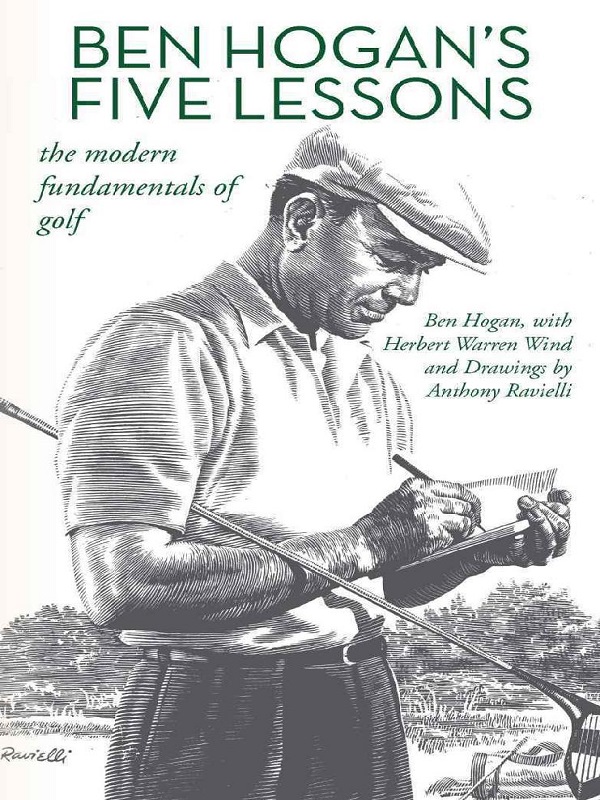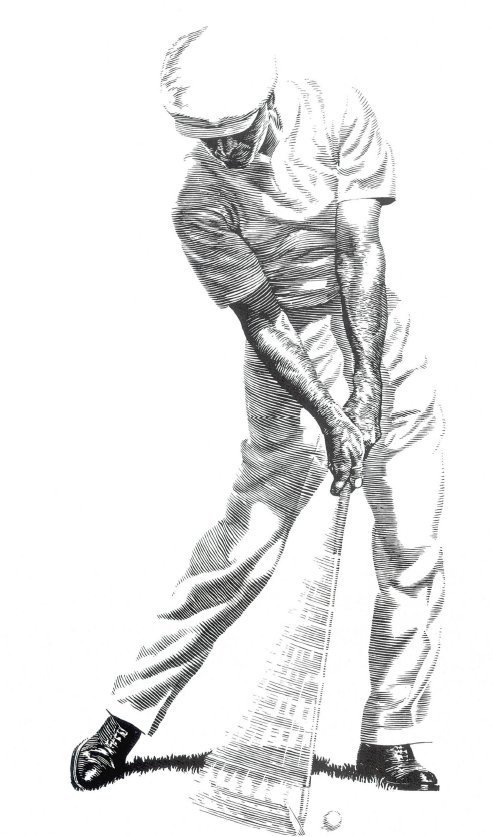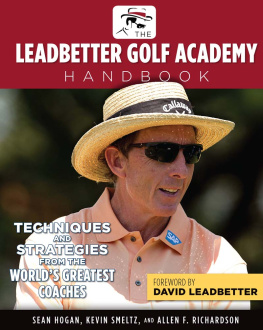Ben Hogans Five Lessons
The Modern Fundamentals of Golf
Ben Hogan, with Herbert Warren Wind and Drawings by Anthony Ravielli
Digital Edition Published 2018 House of Majied Publications
Contents
Twenty-five years ago, when I was 19, I became a professional golfer. I suppose that if I fed the right pieces of data to one of our modern electronic brain machines it would perform a few gyrations and shortly afterwards inform me as to how many hundreds of thousands of shots I have hit on practice fairways, how many thousands of shots I have struck in competition, how many times I have taken three putts when there was absolutely no reason for doing so, and all the rest of it. Like most professional golfers, I have a tendency to remember my poor shots a shade more vividly than the good ones the one or two per round, seldom more, which come off exactly as I intend they should.
However, having worked hard on my golf with all the mentality and all the physical resources available to me, I have managed to play some very good shots at very important stages of major tournaments. To cite one example which many of my friends remember with particular fondness and I, too, for that matter in 1950 at Merion, I needed a 4 on the 72nd to tie for first in the Open. To get that 4 I needed to hit an elusive, well-trapped, slightly plateaued green from about 200 yards out. There are easier shots in golf. I went with a two-iron and played what was in my honest judgment one of the best shots of my last round, perhaps one of the best I played during the tournament. The ball took off on a line for the left-center of the green, held its line firmly, bounced on the front edge of the green, and finished some 40 feet from the cup. It was all I could have asked for. I then got down in two putts for my 4, and this enabled me to enter the playoff for the title which I was thankful to win the following day.
I bring up this incident not for the pleasure of retasting the sweetness of a big moment but, rather, because I have discovered in many conversations that the view I take of this shot (and others like it) is markedly different from the view most spectators seem to have formed. They are inclined to glamorize the actual shot since it was hit in a pressureful situation. They tend to think of it as something unique in itself, something almost inspired, you might say, since the shot was just what the occasion called for. I dont see it that way at all. I didnt hit that shot then that late afternoon at Merion. Id been practicing that shot since I was 12 years old. After all, the point of tournament golf is to get command of a swing which, the more pressure you put on it, the better it works.
In some important respects, tournament golf and golf are as foreign to each other as ice hockey and tennis. In other respects theyre not: the professional shooting for his livelihood on the circuit (with his pride, some pleasure, and thousands of dollars at stake) and the average golfer trying to produce his best game on weekends (with his pride, his pleasure, and a dollar Nassau at stake) are both searching to master the movements that will result in a repeating swing A CORRECT, POWERFUL, REPEATING SWING. This can be stated categorically: it is utterly impossible for any golfer to play good golf without a swing that will repeat.
How then do you build a swing that you can depend on to repeat in all kinds of wind and weather, under all kinds of presses and pressure? Having devoted the bulk of my waking hours (and a few of my sleeping hours) for a quarter of a century to the pursuit of the answer, I now believe that what I have learned can be of tremendous assistance to all golfers. That is my reason for undertaking this series of lessons. I do not propose to deal in theory. What I have learned I have learned by laborious trial and error, watching a good player do something that looked right to me, stumbling across something that felt right to me, experimenting with that something to see if it helped or hindered, adopting it if it helped, refining it sometimes, discarding it if it didnt help, sometimes discarding it later if it proved undependable in competition, experimenting continually with new ideas and old ideas and all manner of variations until I arrived at a set of fundamentals that appeared to me to be right because they accomplished a very definite purpose, a set of fundamentals which proved to me they were right because they stood up and produced under all kinds of pressure. To put it briefly, the information I will be presenting is a sifting of the knowledge Ive tried to acquire since I first met up with golf when I was 12 and knew, almost immediately, I wanted to make the game my lifework.
Up to a considerable point, as I see it, theres nothing difficult about golf, nothing. I see no reason, truly, why the average golfer, if he goes about it intelligently, shouldnt play in the 70s and I mean by playing the type of shots a fine golfer plays. Somehow most average golfers get it into their head that they cant play a long shot correctly, that they havent got the skill or coordination to execute a full swing. Putting or chipping, thats another story. The average golfer feels he can cope pretty successfully with those parts of the game all they require is a short swing. In my opinion, the average golfer underrates himself. He has all the physical equipment he needs to execute the full golf swing and hit full shots. A full swing is nothing more or less than an extension of the short swing. Like everything, it takes some learning, but learning the correct movements is 10 times less difficult than he thinks. In fact, once you are on the right track in golf, doing things the right way takes a lot less effort than the wrong way does.
I realize that in some ways I can be a demanding man and that some things are harder for certain people to do than I may appreciate, but it really cuts me up to watch some golfer sweating over his shots on the practice tee, throwing away his energy to no constructive purpose, nine times out of 10 doing the same thing wrong he did years and years back when he first took up golf. This sort of golfer obviously loves the game or he wouldnt be out there practicing it. I cannot watch him long. His frustration all that fruitless expenditure of energy really bothers me. If he stands out there on the practice tee till hes 90, hes not going to improve. Hes going to get worse and worse because hes going to get his bad habits more and more deeply ingrained. I know that thousands of golfers console themselves with the games being an avenue to exercise and companionship which is wonderful but every golfer, at the bottom of his heart, wants to play the game relatively well. To do that takes some application, some thought, some effort, but the golfer who goes about this wisely will play good golf and should go on to enjoy his golf increasingly the rest of his life. The greatest pleasure is obtained by improving.
Before we commence the instruction, let me tell you more specifically what we will be doing and what we hope to accomplish. To begin with, the book will comprise five lessons. In each one we will be presenting the golfer-reader with one or two fundamentals for him to practice and become well acquainted with so that he will be building a progressively sound foundation on which the ensuing fundamentals can be added. The golfer who devotes a half hour daily to practicing the points we will be bringing out during these five lessons will, I believe, improve his game and his scoring immediately and decisively. The degree of improvement his game will show will vary with the quality of each individuals application. By continuing to practice and apply these fundamentals, the golfer will continue to improve his game quite often, far beyond his fondest dreams. I do genuinely believe this: THE AVERAGE GOLFER IS ENTIRELY CAPABLE OF BUILDING A REPEATING SWING AND BREAKING 80, if he learns to perform a small number of correct movements and conversely, it follows, eliminates a lot of movements which tend to keep the swing from repeating. In these lessons we will certainly not be attempting to cover all of golf or even one-hundredth of that almost inexhaustible subject. What we will be concerning ourselves with are the facts of golf which have proved themselves to be the true fundamentals fundamentals that can be checked and not simply left to the imagination or to guesswork. This is all that is really needed.










